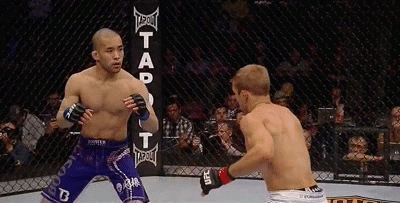The Progressive Indirect Attack is an offensive action preceded by a feint or a light strike with an aim of misleading the adversary. The feint or the light striking can be used to create openings, to cause a reaction, to create space or to save time.
An adversary which has a good and compact guard is difficult to reach with a single attack. With the Progressive Indirect Attack, which is based on the feints, you can lead your opponent to open his guard to block or avoid your strikes. When the adversary opens while following the trajectory of the feint, you can aim at the opening. You can make more than one feint, without exaggerating too much.
- The feints must be convincing and fast to increase the chances to have a reaction of the opponent. The feints can be used to cause a reaction, reduce the distance, modify positioning and save time.
- Striking following to the feint must be on a different line. It must be fast and precise. The rhythm can be broken to surprise and disorganize the opponent.
The Rhythm
When one speaks about rhythm in combat, it is the time intervals between our actions. The rhythm can be given with strikes, movements of head, footwork etc. The rhythm can be regular or irregular. It can also be broken. When you become aware of the rhythm, you can control it and use it to your advantage. You can change your speed during the combat and adjust according to what occurs (to find the good rhythm which favours you compared to the adversary).
During the fight, you can give a regular and slow beat “to hypnotize” your adversary and to study his reactions. When its reactions is analyzed, you can launch a Progressive Indirect Attack with a faster rhythm. (beats / half-beats)
The Distance
The Progressive Indirect Attack is generally carried out forwards. Thanks to the feints, you can not only create an opening but also gain the distance you want to launch the attack which will reach the selected target.
The Feints
There is several types of feints and they have all their utilities. To make an effective feint, it is necessary to be credible, the movements must be realistic.
Here are a few types of feints:
- Body/Head feints – Feint having for goal to create an opening to the body or the head.
- Shifting feints – Feint having for goal to cause a reaction of the adversary and to compromise its position.
- Eye feints – Feint having for goal to distract and draw attention at a particular place using your eyes.
- Technical feints – Feint having for goal to cause a reaction by acting the beginning of a technique and to continue with another thing.
- Other feints – One can make movements with the arms to confuse the adversary, one can strike completely beside a target to make the adversary move, etc…
Programmed Feint: Consist in feinting the first blow in order to reach a target supposed to be uncovered with the second blow. The one who makes the feint must anticipate the reaction of the adversary.
Adaptive Feint: Consist in evaluating the reaction of the adversary when the feint is thrown and take the opportunity to attack the openings.
Here is a short list of Progressive Indirect Attacks
- feint jab, lead hook
- feint jab, outside low kick
- feint jab, side kick
- feint jab, feint jab to body, overhand
- feint jab to body, rear uppercut
- feint cross, rear high kick
- feint outside low kick, low kick on rear leg
- feint outside low kick, rear super man punch
- feint lead push kick, jab
- Look the feet, jab
- feint spinning back fist, spinning back kick





